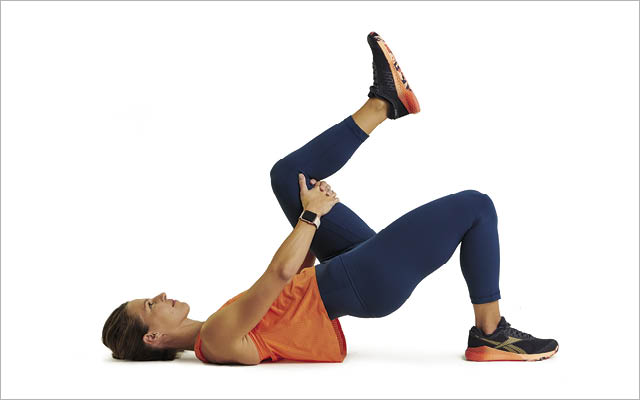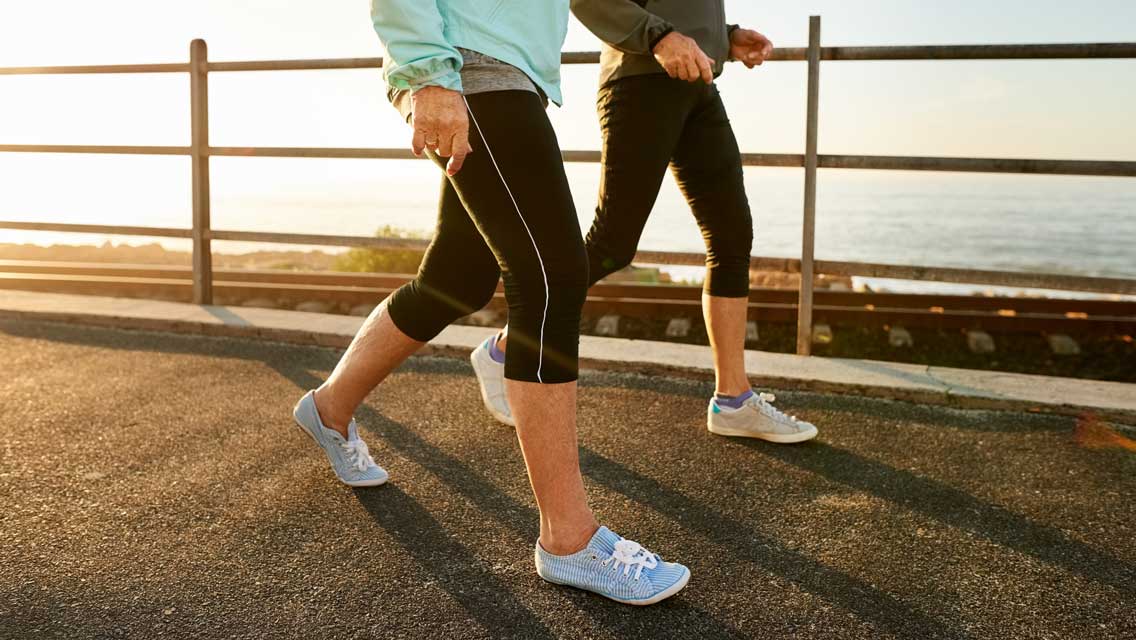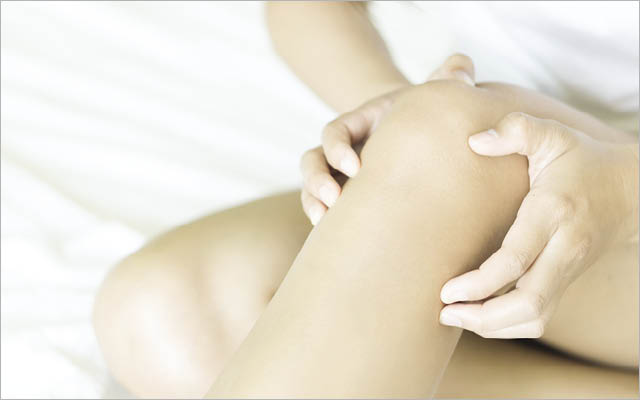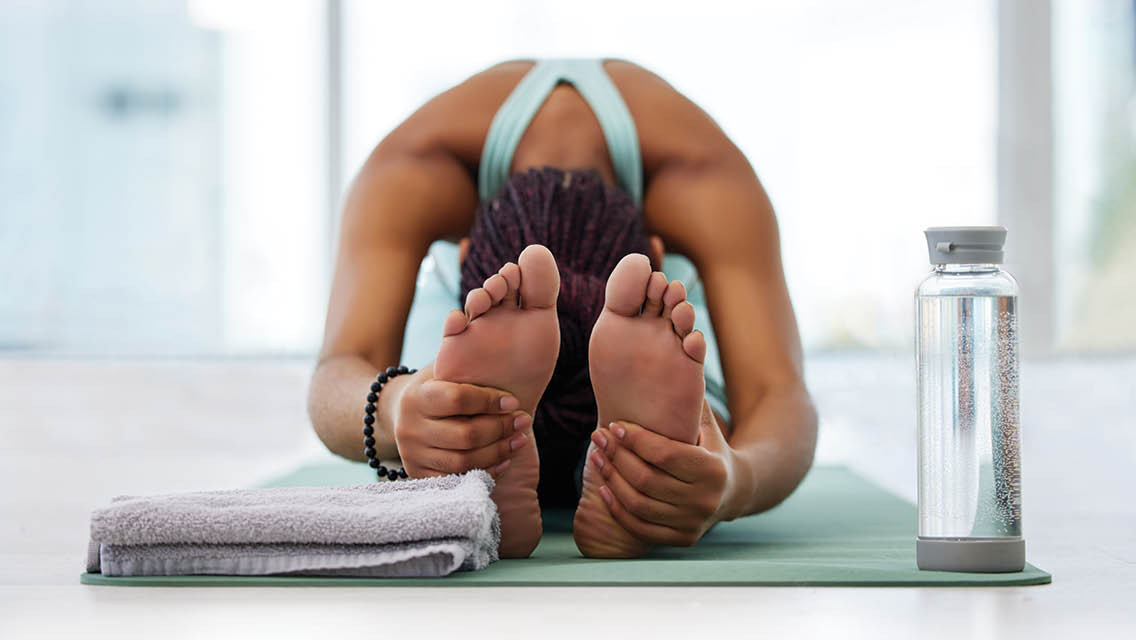Mastering mobility, stability, and strength exercises, like these recommended by Life Time’s LifeClinic physical therapist Debbie Lensing, DPT, OCS, Cert-DN, can play a major role in keeping your knees healthy for life. Perform the first two moves every day and the other moves three or four times per week.
Note: If you have moderate knee pain that doesn’t improve after two weeks, consult a physical therapist about targeted treatment. If you can’t walk without limping, suffer from acute knee pain and swelling, or have been diagnosed with a medical condition like osteoarthritis, seek professional help before beginning this program.
1. Mulligan Mobilization With Ankle Movement
This move increases ankle mobility, which helps prevent compensation at the knees when you squat or climb stairs.
Wrap a resistance band around one ankle below the ankle bone and attach the other end to an anchor behind you. Kneel on the floor on your opposite knee so the foot with the resistance band is planted in front of you and both knees are bent 90 degrees.
- Keeping your lead foot flat on the floor, and with a strong stretch on the band, slowly push your front knee forward as far as you can without lifting your heel off the floor.
- Once you can’t go any farther, pull your front knee back to starting position. Perform 20 reps before switching to the other side. Try to do this move two or three times per day.
- If this move is hard on your back knee, kneel on a yoga mat or blanket.
2. Foam Rolling Quads and Hip Flexors
Loosening your hip-flexor and quad muscles with a foam roller can help release pressure on the knee cap.
- Lie face-down on a foam roller so the roller is horizontal and supports your quad muscles (the muscles in the front of your thighs). Support your upper body with your forearms on the floor.
- Roll back and forth on the foam roller for one to two minutes, going from your hip flexors just below your hip bones to the bottom of your quad muscles just above your knees.
- Aim to roll out two or three times per day, as well as after your workout when your muscles are warm.
3. Single-Leg Bridge With Knee toward Chest
Use this exercise to activate your glute muscles before tackling more challenging glute-focused strength moves. Pulling one knee to your chest at the top of the exercise helps prepare your glute muscles for moves like lunges, split squats, and running, and can be especially helpful to counteract overactive hip flexors.
- Lie on your back with your knees bent and feet hip width apart on the floor.
- Lift one foot off the floor to bring your knee toward your chest. Interlace your fingers beneath your knee to help guide it gently as far as you can without sacrificing form.
- Push through your heel and squeeze your glutes to lift your hips off the floor.
- Hold briefly before returning your hips to the floor. You should feel this move primarily in your glutes, and minimally in your hamstrings and lower back.
- Perform two or three sets of 20 reps per side. If this move is too challenging, start by simply raising one foot off the floor from bridge position. Or keep both feet on the floor until you’re ready to try the single-leg version.
4. Banded Lateral Walk
Strengthen your side-butt muscles to shore up hip stability and prevent your knees from collapsing inward while running or squatting.
- Stand with legs hip width apart and loop a resistance band around your ankles below the bone. You should feel mild to moderate tension in the band.
- Bend your knees slightly and step one foot to the side. Immediately follow with the opposite foot so your legs are once again hip width apart. Continue stepping in the same direction for 20 steps total, then repeat in the opposite direction. Perform two or three sets.
- Keep your torso steady as you side-step to avoid rocking motions. To make the move easier, use a band with less resistance, take smaller steps, or move the band up above the knees. To make the move more challenging, use a heavier resistance band, take wider steps, or loop the band around your forefeet.
5. Single-Leg Box Squat
Runners in particular will benefit from mastering this squat. “You’re leaping from one leg to another repeatedly, sometimes for 13.1 to 26.2 miles,” Lensing explains. But even if you’re not a runner, the single-leg squat will assist you in building glute strength and overall balance, which helps offload pressure from your knees.
- Set up a box or bench one foot behind you. The surface height will depend on how deep you’re able to squat comfortably and with control, so start with a higher surface and adjust as needed.
- Shift your weight onto one leg and lift the opposite foot a few inches off the floor in front of you.
- Push your butt back and bend your standing knee to sit back into your hips. Tap the box or bench with your butt, then push through your standing foot to return to starting position. Perform two or three sets of 15 reps per leg.
- Keep your stance knee in line with your toes; don’t let your knee travel in front of your toes or collapse inward or outward.
- Gradually lower the box or bench height until you’re able to squat at full depth (thighs at or below parallel to the floor). To make the move easier, raise the box or bench height, or kickstand your opposite foot to help you balance.
6. Single-Leg Squat reach
Once you’ve mastered the single-leg box squat, progress to this next-level version that incorporates a functional rotational movement. This single-leg move will challenge you to keep your knee steady while you rotate, which is especially helpful for people who run or play rotational sports like baseball or tennis.
- Stand with feet hip width apart and arms at your sides. Shift your weight onto one leg and lift your opposite foot off the floor a few inches behind you. Push your butt back and bend your standing knee to sit back into your hips.
- Keeping your back flat and knee in line with your toes, reach your opposite hand toward the outside of the standing foot. Return to standing, then reach your other hand to the inside of your standing foot.
- Perform 10 reaches per hand on one leg before switching to the other. Do two or three sets.
- To make the move easier, place a slider or folded towel under your back foot and simply slide it backward instead of lifting it off the floor. To make the move more challenging, reach while holding 5 to 10 pounds in each hand.
This originally appeared as “Knee Know-How” in the December 2019 print issue of Experience Life.




This Post Has 0 Comments